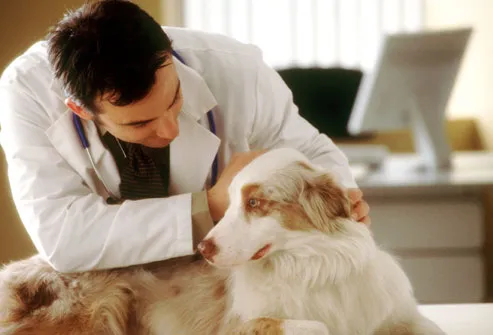Dog Skin Problems
The sound of a dog constantly scratching or licking can be as irritating as nails on a chalkboard. But don’t blame your pooch for these bad habits -- a skin condition is probably the culprit. Possible causes range from parasites to allergies to underlying illness. WebMD has compiled images of some of the most common canine skin problems.Allergic Dermatitis
Dogs can have allergic reactions to grooming products, food, and environmental irritants, such as pollen or insect bites. A dog with allergies may scratch relentlessly, and a peek at the skin often reveals an ugly rash. Corticosteroids can help with itchy rashes, but the most effective treatment is to identify and avoid exposure to the allergens.
Yeast Infection
Impetigo
Another type of bacterial infection, impetigo is most common in puppies. It causes pus-filled blisters that may break and crust over. The blisters usually develop on the hairless portion of the abdomen. Impetigo is rarely serious and can be treated with a topical solution. In a small number of cases, the infection may spread or persist.Seborrhea
Seborrhea causes a dog's skin to become greasy and develop scales (dandruff). In some cases, it's a genetic disease that begins when a dog is young and lasts a lifetime. But most dogs with seborrhea develop the scaling as a complication of another medical problem, such as allergies or hormonal abnormalities. In these cases, it is vital to treat the underlying cause so symptoms do not recur.Ringworm
Despite its name, ringworm is not caused by a worm, but by a fungus. The term "ring" comes from the circular patches that can form anywhere, but are often found on a dog's head, paws, ears, and forelegs. Inflammation, scaly patches, and hair loss often surround the lesions. Puppies less than a year old are the most susceptible, and the infection can spread quickly between dogs in a kennel or to pet owners at home. Various anti-fungal treatments are available.Shedding and Hair Loss (Alopecia)
Anyone who shares their home with dogs knows that they shed. How much shedding is normal depends on breed, time of year, and environment. But sometimes stress, poor nutrition, or illness can cause a dog to lose more hair than usual. If abnormal or excessive shedding persists for more than a week, or you notice patches of missing fur, check with your veterinarian.Fleas
Fleas are the bane of any pet owner. You may not see the tiny insects themselves, but flea droppings or eggs are usually visible in a dog's coat. Other symptoms include excessive licking or scratching, scabs, and hot spots. Severe flea infestations can cause blood loss and anemia, and even expose your dog to other parasites, such as tapeworms. Treatment may include a topical and/or oral flea killer and a thorough cleaning of the pet's home and yardColor or Texture Changes
Changes in a dog's skin color or coat texture can be a warning sign of several common metabolic or hormone problems. Be sure to ask your veterinarian about any significant changes to your dog’s coat.Dry, Flaky Skin
Dry, flaky skin can be a red flag for a number of problems. It's a common symptom of allergies, mange, and other skin diseases. But most often, dry or flaky skin is nothing serious. Like people, some dogs simply get dry skin in the winter. If this seems to cause your pet discomfort, consult your veterinarian.Immune Disorders
In rare cases, skin lesions or infections that won’t heal can indicate an immune disorder in your dog. One of the best known is lupus, a disease that affects dogs and people. Lupus is an autoimmune disorder, meaning the body’s immune system attacks its own cells. Symptoms include skin abnormalities and kidney problems. It can be fatal if untreated.Anal Sac Disease
As if dog poop weren't smelly enough, dogs release a foul-smelling substance when they do their business. The substance comes from small anal sacs, which can become impacted if they don't empty properly. The hallmark of impacted anal sacs is a dog scooting his bottom along the ground. Other symptoms include biting or licking the anal area. A vet can manually express full anal sacs, but in severe cases, the sacs may be surgically removed.
















0 comments:
Post a Comment